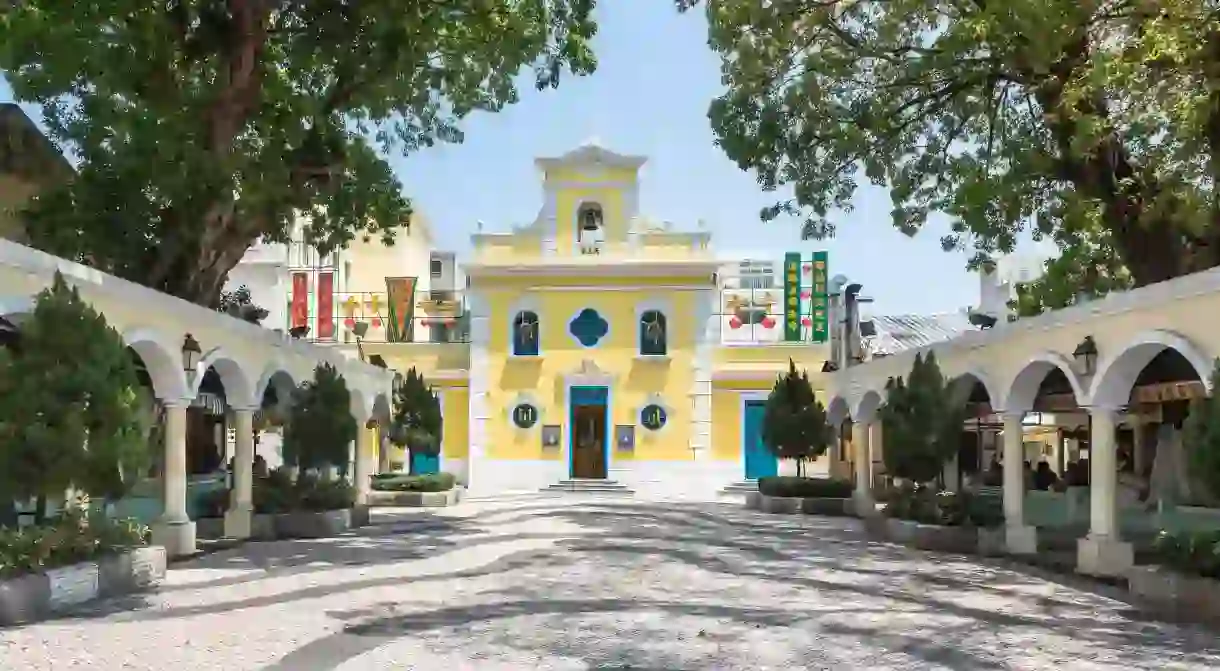11 Photo-Worthy Locations in Macau You Must Visit

Food, culture and a mix of architecture – ancient, ornate temples, 19th-century monuments, Art Deco shophouses – give Macau its unique identity. If you want to make beautiful memories and take some even more beautiful pictures in this Portuguese-infused corner of Asia, head to these distinctly Macanese buildings, streets, parks, squares and markets.
Guia Fortress
This UNESCO Heritage Site is a 17th-century fort, chapel and lighthouse in São Lázaro. Painted white and a cheery bright yellow, the colonial architectural site is easily accessible by a light hike or cable car. Blue-sky backdrops make for postcard-perfect images, and the cannons are still in place for any military-themed shoots. To avoid photo-ruining crowds, head here on a weekday.

Taipa Village
The colourful shophouses of Taipa Village and the pastel-green colonial Taipa Houses-Museum are popular with couples having their wedding photos taken. Head up to the roof of the Tapas de Portugal restaurant for sundowners and to enjoy the view of the village – reminiscent of panoramic views over Lisbon’s rooftops. Swing by the cha chaan tengs (local diners) for some buttery Portuguese egg tarts over a hot, steaming cup of traditional milk tea and to capture the old-school charm for your Instagram.

Mandarin’s House
Built in the 19th century, the traditional residential compound of Chinese reformist Zheng Guanying provides varied backgrounds for photography. The circular entryways, decorative motifs and carved-plaster reliefs remain, as do the green-glazed tiles on the courtyard walls. Wander into the residence, admire the extensive detailing on the windows and doors as well as its lush gardens, and imagine what it would have been like to be a part of Chinese high society.

Ruins of St Paul’s
You’ll find this UNESCO Heritage Site on many postcards of Macau. However, aspiring photographers should head behind the ruins to the 19th-century Na Tcha Temple, which offers unobstructed views of old and new Macau, with the Grand Lisboa hotel rising gracefully on the skyline.

Luís de Camões Garden
Named after Portugal’s most famous poet, who lived in Macau during one of his many exiles, Luís de Camões Garden is among the city’s largest and most popular public parks. It has extensive winding paths, granite boulders and ornamental Chinese pavilions in which you can sit and perfect your photography or still-life painting.

Rua de Felicidade
Also known as Happiness Street, Macau’s former red-light district was inhabited by prostitutes during the colonial days. The thrilling car chase through the “streets of Shanghai” in Indiana Jones and the Temple of Doom (1984) was also shot here. At the end of the street are inns where Wong Kar Wai filmed scenes for In the Mood for Love (2000) and 2046 (2004). Although the street, with its signature red doors and windows, has been modernised, it is still a pleasant place for a wander.

Macao Science Center
As you pull into the harbour on the ferry from Hong Kong, architect IM Pei’s masterpiece looks like a giant microscope. The best times for photos are at dawn and dusk, when the sunrise and sunset glow over its futuristic facade. Inside the building, you might feel as if you’ve boarded a spaceship – neon-blue lights illuminate the curves of its widely spiralling stairs. Natural light streams in from a skylight, causing shadows to play on the interiors in different ways at different times of the day.

Senado Square
This is the heart of the Macau Peninsula. Drone footage and other bird’s-eye views show the extent of the black-and-white swirls of Portuguese tiled flooring – the same ones you’ll find in Lisbon. Pockets of colourful buildings, from churches to shops, surround the square. Head from here to Largo de Santo Agostinho to see more pastel-green colonial buildings, including the 19th-century Dom Pedro V Theatre. This Neoclassical building was used as a refugee shelter during World War II, and it was added to the list of UNESCO Heritage Sites in 2005.

A-Ma Cultural Village
Take a short walk up the hill in Seac Pai Van Park in Coloane and you’ll arrive at the A-Ma Cultural Village. Covering over 7,000 square metres (75,350 square feet), it comprises a temple and a large statue of A-Ma, the goddess of seafarers. The compound has a series of stepped terraces, and the main temple hall is built in traditional Chinese architectural style, topped with green-glazed tile roofs and ornate carvings of animals. Those with wide-angled cameras will appreciate the vast landscape.

Cotai Strip
The Cotai Strip is Macau’s answer to Las Vegas, and it’s home to some stellar hotel architecture. There’s the MGM Grand, Galaxy resorts, Venetian Macao, and the Parisian Macao as well as Zaha Hadid Architects’ futuristic Morpheus for Melco, the world’s first high-rise exoskeleton, and Studio City. Elsewhere, grand dame Wynn Palace has cable cars for the best views of the musical fountain light show. Bright and shiny with dazzling lights, the Strip makes for an unrivalled night of long-exposure captures.

Red Market
Designed by architect Júlio Alberto Basto, the Red Market is a colonial, three-storey wet market (where meat and live animals are sold) that gets its name from the colour of its exteriors. Built in 1936, the UNESCO Heritage Site has a clock tower in its centre and a watchtower at each corner. This busy daily market is full of moments of local Macanese life, perfect if you’re looking for more documentary-type stills.

Inspired to visit Macau? Learn more at Macao Government Tourism.
This branded content article was published as part of a commercial campaign that has now ended.













